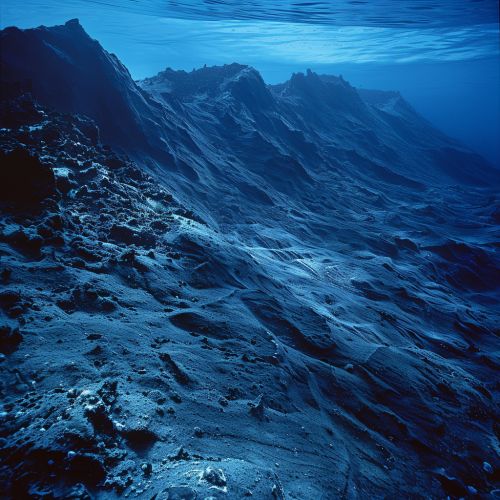Oceanic spreading ridge
Introduction
An oceanic spreading ridge, also known as a mid-ocean ridge, is an underwater mountain range formed by plate tectonics. This geological feature is characterized by the upwelling of magma from the mantle, which creates new oceanic crust as tectonic plates diverge. Oceanic spreading ridges are fundamental to the process of seafloor spreading and play a crucial role in the dynamics of Earth's lithosphere.
Geological Setting
Oceanic spreading ridges are found at divergent plate boundaries, where two tectonic plates move away from each other. These ridges are typically located in the middle of ocean basins and are the longest continuous mountain ranges on Earth. The Mid-Atlantic Ridge, for example, extends from the Arctic Ocean to the Southern Ocean, bisecting the Atlantic Ocean.


The process of seafloor spreading at these ridges is driven by mantle convection, where hot, buoyant material rises from the mantle, creating a ridge. As the tectonic plates pull apart, magma fills the gap, solidifies, and forms new oceanic crust. This continuous process results in the symmetrical spreading of the seafloor on either side of the ridge.
Morphology and Structure
Oceanic spreading ridges exhibit a variety of morphological features, including rift valleys, volcanic edifices, and hydrothermal vent systems. The central rift valley is a prominent feature, typically characterized by a deep, linear depression flanked by elevated ridges. This valley is formed by the tensional forces associated with plate divergence.
The volcanic activity at spreading ridges is primarily basaltic, producing pillow lavas and sheet flows. These volcanic features are often accompanied by fissure eruptions, where lava emerges from elongated cracks in the crust. The morphology of the ridge can vary significantly depending on the spreading rate. Fast-spreading ridges, such as the East Pacific Rise, tend to have smoother topography and less pronounced rift valleys compared to slow-spreading ridges like the Mid-Atlantic Ridge.
Hydrothermal Activity
Hydrothermal vent systems are a hallmark of oceanic spreading ridges. These systems are formed when seawater percolates through the porous oceanic crust, becomes heated by underlying magma, and then rises back to the seafloor, creating hydrothermal vents. These vents emit mineral-rich fluids that precipitate to form chimney-like structures known as black smokers and white smokers.
The hydrothermal fluids are rich in dissolved metals and sulfides, which support unique biological communities. These ecosystems are based on chemosynthesis, where bacteria and archaea utilize the chemical energy from hydrothermal fluids to produce organic matter. This process supports a diverse array of organisms, including tube worms, clams, and shrimp, which thrive in the extreme conditions of hydrothermal vent environments.
Tectonic and Geochemical Processes
The tectonic processes at oceanic spreading ridges are integral to the cycling of materials between Earth's mantle and crust. The upwelling of mantle material at the ridge axis leads to partial melting, producing basaltic magma. This magma ascends through the crust, where it undergoes fractional crystallization and degassing, influencing the geochemical composition of the newly formed oceanic crust.
The interaction between seawater and the oceanic crust at spreading ridges also plays a significant role in geochemical cycles. Hydrothermal circulation alters the mineralogy and chemistry of the crust, leading to the formation of secondary minerals such as chlorite and serpentine. These processes contribute to the global cycling of elements, including carbon, sulfur, and metals.
Seismicity and Volcanism
Seismic activity at oceanic spreading ridges is primarily associated with the tensional forces of plate divergence and the emplacement of magma. Earthquakes at these ridges are generally shallow and occur along normal faults that accommodate the extensional stress. The seismicity provides valuable insights into the dynamics of ridge processes and the structure of the oceanic crust.
Volcanism at spreading ridges is characterized by frequent, low-intensity eruptions that contribute to the continuous formation of new oceanic crust. The volcanic activity is closely monitored using a combination of seafloor observatories, remote sensing, and submersible vehicles. These monitoring efforts help to understand the temporal and spatial patterns of volcanic eruptions and their impact on the seafloor environment.
Oceanic Spreading Ridge Ecosystems
The unique environmental conditions at oceanic spreading ridges support specialized ecosystems that are distinct from those found in other marine habitats. The primary productivity in these ecosystems is driven by chemosynthetic microorganisms that utilize the chemical energy from hydrothermal fluids. These microorganisms form the base of the food web, supporting a variety of invertebrates and fish.
The discovery of hydrothermal vent communities in the late 20th century revolutionized our understanding of life in extreme environments. These ecosystems are characterized by high biomass and biodiversity, with many species exhibiting unique adaptations to the harsh conditions. Research on these communities has provided insights into the limits of life on Earth and the potential for life in similar environments on other planetary bodies.
Economic and Scientific Significance
Oceanic spreading ridges are of significant economic and scientific interest. The mineral-rich hydrothermal deposits at these ridges contain valuable metals such as copper, zinc, and gold, which have the potential for commercial exploitation. However, the environmental impact of deep-sea mining is a major concern, and efforts are underway to develop sustainable practices for resource extraction.
Scientifically, oceanic spreading ridges are natural laboratories for studying fundamental geological and biological processes. Research on these ridges has advanced our understanding of plate tectonics, mantle dynamics, and the origins of life. The interdisciplinary nature of ridge studies, encompassing geology, geochemistry, biology, and oceanography, highlights the importance of these features in Earth sciences.
